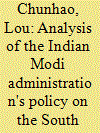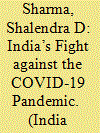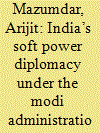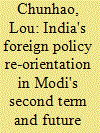| Srl | Item |
| 1 |
ID:
156361


|
|
|
|
|
| Summary/Abstract |
India is becoming increasingly active in the issue of the South China Sea, voicing criticism and taking precautions against China. It is quite possible that India will take advantage of the issue of the South China Sea and will adopt more comprehensive way to get involved in the issue.
|
|
|
|
|
|
|
|
|
|
|
|
|
|
|
|
| 2 |
ID:
183853


|
|
|
|
|
| Summary/Abstract |
In early 2020, when the COVID-19 pandemic was indiscriminately spreading around the world, the seeming ability of India, the world’s second most populous country (with over 1.3 billion people), to contain the virus within its borders and keep COVID-19 infection and mortality rates low relative to population size was seen as miraculous. However, the miracle ended when the ‘second-wave’ hit India in April 2021. On 1 May 2021, India became the first country in the world to record more than 400,000 coronavirus infections in a single day. This exponential rise in COVID-19 cases started on 28 April 2021 when India recorded 379,459 new COVID-19 cases and 3,647 deaths. This marked the eighth straight day of more than 300,000 cases a day—making India the second-highest COVID-19 case count in the world (over 20 million) with over 25 per cent of the global deaths from COVID. The following examines India’s fight against the pandemic, the failure to contain the second wave, the lessons learned and the way forward.
|
|
|
|
|
|
|
|
|
|
|
|
|
|
|
|
| 3 |
ID:
160676


|
|
|
|
|
| Summary/Abstract |
This paper examines the Narendra Modi administration's use of three specific soft power assets of India – Buddhism, Diaspora, and Yoga – in diplomacy in service of the country's national interests. It attempts to address the following questions: What is the main purpose of the Modi administration's soft power strategy and the reasons behind the promotion and utilization of these three assets? What are the impediments to India's soft power projection ability? Finally, how can the Modi administration better exploit India's soft power advantages? This paper demonstrates how the Modi administration is making efforts to project India's soft power in the service of larger strategic goals. The use of soft power is designed to complement India's conventional diplomacy, boost its international image, project it as a peaceful rising power, improve relations with other countries, and help attract foreign investment, technology, and tourists in order to promote economic growth and development.
|
|
|
|
|
|
|
|
|
|
|
|
|
|
|
|
| 4 |
ID:
170870


|
|
|